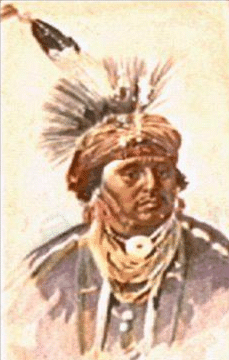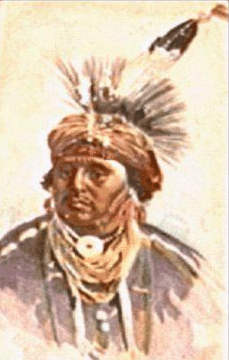 |
 |
 |
 |
 |
 |
The Five Civilized Tribes was a confederation, formed in 1859, of North American Indians in what was then WESTERN INDIAN TERRITORY (in present-day Oklahoma). The group comprised the Iroquoian- speaking CHEROKEE and the Muskogean-speaking CHICKASAW, CHOCTAW, CREEK, and SEMINOLE. They were described as "civilized" because of their early adoption of many of the white man's ways. Under the Indian Removal Act of 1830, the Five Tribes were deported from their traditional homelands east of the Mississippi and forced to settle in Indian Territory. Each organized an autonomous state modeled after the U.S. federal government, established courts and a formalized code of laws, constructed schools and Christian churches, and developed a writing system patterned on the one earlier devised by the CHEROKEE. The removal of the Five Civilized Tribes to Oklahoma was a process which lasted more than 20 years, beginning with CHOCTAW treaties of 1816, 1820, and 1825 and the CHEROKEE treaties 1817, 1828, and 1835. The movement ended with the efforts to comb the SEMINOLES out of the Florida swamps in 1835-42 Members of the Five Tribes absorbed many cultural features of their white neighbors, including plow agriculture and animal husbandry, European-style houses and dress, and even the ownership of black slaves. Some tribesmen joined the Confederate forces during the Civil War. Thereafter the United States instituted a policy of detribalization and gradually curtailed Indian control of tribal lands. The tribal nations remained independent until 1907, when statehood was granted to Oklahoma and the federal government opened WESTERN INDIAN TERRITORY to white settlement. Today, a great many descendants of the Five Tribes live on reservations in Oklahoma. Before forced settlement in WESTERN INDIAN TERRITORY, the members of the Five Tribes, some of which were traditionally enemies, shared many culture traits. All relied primarily on maize agriculture, with fishing, hunting, and foraging an important but subsidiary means of subsistence. Village life was highly developed. Households generally included small extended families, with kinship based on a matrilineal clan system. Among the more western tribes, notably the Creek, social stratification existed in the form of noble and common classes that were marked by their mode of dress. Independent communities were politically integrated into confederacies. Temple architecture, ceremonial centers, and elaborate rituals -- such as the CORN DANCE -- existed, centered on the growing of corn and worship of the Sun. Traditional crafts included coiled pottery, woven blankets, and articles of wrought copper. Indian Territory The term Indian Territory was originally applied vaguely to huge areas of the western United States occupied by the American Indians. Laws passed in the 1830s, however, most notably the Indian Removal Act (1830) and the Indian Trade and Intercourse Act (1834), defined Indian Territory as the area of present-day Oklahoma, Kansas, Nebraska, and the Dakotas to which Indian tribes were then being forcibly moved. By creating the territories of Kansas and Nebraska, with the KANSAS-NEBRASKA ACT (1854) further limited the area to the territory of the FIVE CIVILIZED TRIBES in present-day Oklahoma. Because the Indians had allied themselves with the Confederacy, these tribes were forced by new treaties negotiated in 1866 to relinquish the western half of their territory, which became part of the Oklahoma Territory. In 1907 the remaining Indian Territory was absorbed with the Oklahoma Territory into the new state of Oklahoma. OKLAHOMA Spanish and French explorers, in search of the proverbial pot of gold at the end of the rainbow, traversed the Oklahoma section time and time again as early as 1541. (Chronicler of the Coronado expeditions, of Capt. JUAN JARAMILLO and RODRIGO RANJEL) At this time there were only two main types of Indians in the area now known as Oklahoma: the nomadic, bison-hunting Plains tribes (principally the Kiowas, Commanches, and Kiowa-Apaches) and the sedentary, agricultural village tribes (Caddoan-speaking peoples notably the Wichitas and the Caddos proper). "Westward" for the red man ended with Oklahoma when it became the last gathering place of the displaced Indian. Here the Indian gave up the nomadic existences of his forefathers and was forced to accept the white man's mode of living. THE LAST OF THE INDIANS: In 1819 the United States government began forcing the Indians to give up their homes in the southeast and move westward to the INDIAN TERRITORY. For the next two decades the CHEROKEES, CHOCTAWS, CREEKS, CHICKASAWS, and SEMINOLES were uprooted from their ancestral homes in the southeastern states and moved under military escort to the wilderness west of the Mississippi River, which had been acquired in 1803 with the Louisiana Purchase. This was one of the most dramatic, and un-honorable, of all events in American history, this mass exiling of Native Americans. To their credit, these so called "Five Civilized Tribes" set about energetically to recreate new "permanent" homes, sometimes with coals carried all the way from the communal hearth of their old homes. Capitals were established, courts set up (all but the Siminoles had written constitutions), and schools provided for. Then, after a brief era of progress, came the Civil War; and the tribes, with divided loyalties, found themselves engaged on both sides, North and the South. Says historian EDWIN C. McREYNOLDS, "No part of the South or the boarder region where the actual fighting took place, suffered losses more horrible than those of the Indian Territory." Life and property alike were destroyed and there was a general lowering of moral levels and of political and educational activities. Reconstruction for the Indians meant starting at the bottom. This process was soon interrupted by the coming of the railroads, "a powerful factor" according to McReynolds, "in the final surrender of the natives to the culture developed by the European invaders of North America." Another blow to the hopes of the Indians for keeping their reservations free of white men was provided by the cattle drives. At the end of the Civil War a steer on the Texas range was worth four or five dollars. At the market, reached by the railroads penetrating Kansas and Nebraska, the same steer brought as much as one hundred dollars. The "Chisholm Trail" and later the "Western Trail" were soon clogged with giant herds of northbound cattle. During the 1870's, at the height of these cattle drives, as many as 400,000 to 600,000 cattle were herded across western Oklahoma. About this same time many northern and eastern tribes, unwanted elsewhere in an expanding country, were moved into western Oklahoma on land taken from the "Five Civilized Tribes" as punishment for their participation in the Civil War on the side of the South. WHITE SETTLEMENT: By 1889 all of present-day Oklahoma, with the exception of the so-called "Unassigned Lands" in the center of the state, was occupied by, or assigned to, various Indian tribes. However, this center section of rich farming land had already been invaded by "boomers", bands of impatient settlers. Each time these white settlers were rounded up by the U.S. Army and expelled. But the pressure finally became too great, and on Aug. 22, 1889, Congress authorized the first of Oklahoma's illfamed "runs". At the sound of a pistol shot, some 50,000 hopeful greedy homesteaders poured across the line in Creek and Seminole land. By nightfall Oklahoma Territory was a going concern, with thousand of boisterous tent cities dotted over the prairie. During the influx of new settlers, Illinois, Iowa and Kansas farmers seemed to favor the western and northwestern sections of the state, while those from Arkansas, Missouri and Texas preferred the southern and eastern parts of the state. TERRITORIAL PERIOD AND STATEHOOD: After Oklahoma became part of the United States with the Louisa Purchase in 1803, it was included in the Indiana Territory. In 1812 it was combined with the Missouri Territory, and in 1819 with the Arkansas Territory. For several years, most of Oklahoma was included in what was called the Indian Territory, which continued until about 1893 when the section was divided into Indian Territory and the Oklahoma Territory, the latter being thrown open to white settlements. On May 2, 1890 the Territorial Government was established with Guthrie as its first Capital, an island of whites surrounded by Indians. This situation could not last long. Three small reservations nearby were opened to whites by the "run" in 1891. The vast Cheyenne and Arapaho Reservation to the west were similarly opened Apr. 1892, and the Cherokee Outlet on Sep. 16, 1893. The Kickapoo land was opened in 1895. And from July 9 to August 6, 1901, a giant lottery threw open to settlement the Kiowa, Comanche, and the Apache Reservation to the southwest. The days of Indian Territory to the east (which were told they would become a separate state) were numbered. A court decision and an act of Congress awarded Green County to Oklahoma in 1896. Prior to that time it had been claimed by both Oklahoma and Texas. The state of Oklahoma created by the enabling act of June 16, 1906. All Indian Nations perished. Oklahoma became the 46 state to enter the Union when it was admitted November 16, 1907. The Capital was moved from Guthrie to Oklahoma City on June 12, 1910. Source & Reference Notes! Bailey, Minnie T., Reconstruction in Indian Territory (1972); Cotterill, Robert S., The Southern Indians; The Story of the Civilized Tribes before Removal (1954); Debo, Angie, A History of the Indians of the United States (1970; repr. 1984); Debo, Angie, And Still the Waters Run (1984); Foreman, Grant, The Five Civilized Tribes (1934; repr. 1966) Foreman, Grant, Indian Removal: The Emigration of the Five Civilized Tribes (1932; repr. 1966); Gibson, A., The American Indian (1980); Perdue, T., Nations Remembered (1980); McDonnell, Janet A., The Dispossession of the American Indian, 1887-1934 (1991); Swanton, John R., The Indians of the Southeastern United States (1946). Weeks, Philip, Farewell, My Nation: The American Indian and the United States, 1820-1890 (1990). File: NA_VOL03.TXT Revised: Jan. 15, 1995 By: Paul R. Sarrett, Jr. [email protected] End of File!
 NAI - Index |
 SFA - Index |  SFA - REF. |
 E-Mail:
Paul R. Sarrett, Jr. Auburn, CA.
E-Mail:
Paul R. Sarrett, Jr. Auburn, CA. Aug. 10, 2001
Aug. 10, 2001